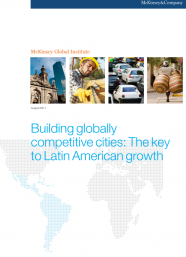
Building globally competitive cities: The key to Latin American growth

Latin America is a bright spot in the post-recession global economy, with growth rebounding strongly in much of the region. In the years ahead, cities will be critical to regional growth. Latin America is more urbanized than any other region in the developing world, with 80 percent of its relatively young population living in cities today, a share expected to rise to 85 percent by 2025. The shift from country to town has contributed much to Latin America’s growth, as economies of scale have boosted the productivity of expanding cities and reduced the cost of delivering basic services to their inhabitants.
MGI examines the multiple challenges that Latin America’s cities must address to fulfill the region’s potential and offers an agenda for urban renewal. Action to reform and develop not only these large cities but rapidly growing middleweight cities is urgent if Latin America is to create the more productive jobs in the formal economy to meet the aspirations of today’s young workforce. The need for action is urgent. In contrast to many other parts of the world, Latin America enjoys favorable demographics, but this situation will not last. By the second half of this century, Latin America’s demographic profile will look more like Europe’s, with a shrinking proportion of economically active young having to provide for a growing fraction of older people. The risk is that the region could grow old before it becomes rich if cities do not fulfill their potential.
- Issue:
- Demography, Urbanization and Migration
- Region:
- Latin America
- Year Published:
- 2011
- Authors:
- Andres Cadena, Jaana Remes, James Manyika, Richard Dobbs, Charles Roxburgh, Heinz-Peter Elstrodt, Alberto Chaia, Alejandra Restrepo
- Institutions:
- McKinsey Global Institute, McKinsey & Company

